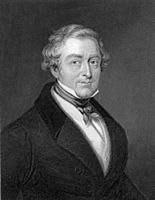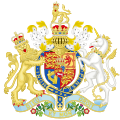First Peel ministry facts for kids
Quick facts for kids First Peel ministry |
|
|---|---|
 |
|
| 1834–1835 | |

Sir Robert Peel
|
|
| Date formed | 10 December 1834 |
| Date dissolved | 8 April 1835 |
| People and organisations | |
| Monarch | William IV |
| Prime Minister | Sir Robert Peel |
| Status in legislature | Minority |
| Opposition leaders | |
| History | |
| Outgoing election | 1835 general election |
| Predecessor | Wellington caretaker ministry |
| Successor | Second Melbourne ministry |
Sir Robert Peel's first government was a short-lived team of leaders in the United Kingdom. It took over from a temporary government led by the Duke of Wellington. Sir Robert Peel himself was the Prime Minister and also handled the country's money as the Chancellor of the Exchequer. The Duke of Wellington, a famous military leader, became the Foreign Secretary, dealing with other countries.
A young politician named William Ewart Gladstone got his very first government job in this team. He started as a Junior Lord of the Treasury. He would later become one of Britain's most famous Prime Ministers, serving for sixty years!
This government was a minority government. This means Sir Robert Peel's party, the Conservatives, did not have enough seats in Parliament to make decisions on their own. They needed help from other parties, especially the Whigs.
However, the Whigs did not want to support the Conservatives. They teamed up with Irish politicians to vote against the government's plans. Because of this, Sir Robert Peel's government was defeated in Parliament many times. After only four months, the government had to resign. Then, the Whig leader Lord Melbourne formed his own government.
Understanding the Cabinet: Who Was Who?
The Cabinet is a group of the most important ministers in a government. They help the Prime Minister make big decisions for the country. Here are the main people in Sir Robert Peel's first Cabinet:
Key Cabinet Members: December 1834 – April 1835
| Office | Name | Role |
|---|---|---|
| First Lord of the Treasury Chancellor of the Exchequer Leader of the House of Commons |
Sir Robert Peel | The head of the government, in charge of the country's money, and leading debates in the House of Commons. |
| Lord Chancellor | The Lord Lyndhurst | The highest judge and head of the legal system. |
| Lord President of the Council | The Earl of Rosslyn | Helped manage government meetings and official business. |
| Lord Privy Seal | The Lord Wharncliffe | Responsible for the King's personal seal on important documents. |
| Home Secretary | Henry Goulburn | In charge of law and order within the country. |
| Foreign Secretary Leader of the House of Lords |
The Duke of Wellington | Dealt with relations between Britain and other countries, and led debates in the House of Lords. |
| Secretary of State for War and the Colonies | The Earl of Aberdeen | Managed the army and navy, and looked after Britain's colonies around the world. |
| First Lord of the Admiralty | The Earl de Grey | The head of the Royal Navy. |
| Master-General of the Ordnance | Sir George Murray | In charge of military supplies and weapons. |
| President of the Board of Trade Master of the Mint |
Alexander Baring | Looked after trade and business, and managed the making of coins. |
| President of the Board of Control | The Lord Ellenborough | Supervised the East India Company, which governed India. |
| Paymaster of the Forces | Sir Edward Knatchbull | Responsible for paying the armed forces. |
| Secretary at War | John Charles Herries | Managed the army's finances and administration. |
Images for kids


